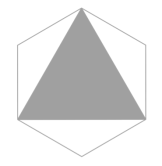I recently led a recreational session at (MC)^2—that’s the Mercer County Math Circle. I called the session “Halving Fun”. I don’t remember exactly how I hit upon halving—maybe because of a partition puzzle I’ve been contemplating—but I knew I was excited to share how much great mathematics can come from such a seemingly simple concept. Here’s the session description:
Join us as we “halve” some fun while creating some art and solving some puzzles that involve breaking shapes in half. What’s the most beautiful way you could cut a square into two equal pieces? Is it always possible to cut a funky shape in half through a specified point? Whether on grids or with free-form shapes, halving tasks provide many fruitful mathematical opportunities. Come explore and these questions and more!
I kicked off the session by showing off some examples of halving art, and giving a little spiel about each.
Here’s the slide deck if it’s useful to you. I also shared the Yoshimoto Friends video that Paul and I made.
Then I set everyone loose to either make some art or try out some of the problem sheets I’d brought. I also had some physical “halving” puzzles and other models for attendees to play with.
Here are the problem sheets:
- It’s Half – I’ve gotten a lot of mileage out of geometric fraction problems like these. On this sheet, you already know that each picture represents a half. The goal is to make clear just why this is the case.
- Half Frames – These are two problems that anyone can work on, but that have rich connections to algebra and geometry.
- Halving – I always share this sheet with my Geometry classes, ever since I found it in Girls’ Angle Bulletin a number of years ago. It’s also a great jumping-off point for students to make problems of their own!
- Half Tetra – This is a template for a 3D puzzle to cut out and fold up. Two identical pieces combine to make a regular tetrahedron. Cardstock recommended. Via Futility Closet.
Attendees made some lovely Truchet-inspired drawings, and one attendee especially dug into the half frames problem—coming up with an interesting conjecture in the process. :) A middle school math teacher who attended even planned to share some of the problems with her students. Maybe you’ll find fit to do so, too. Let me know if you do!


